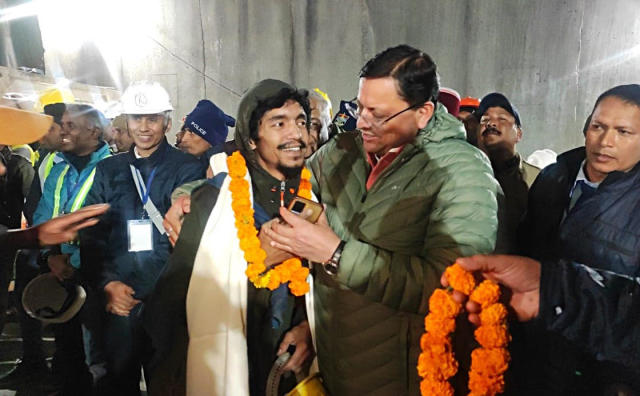Forty-one construction workers held captive for seventeen days became a beacon of hope for the nation.
On Tuesday, rescue teams achieved a triumph, successfully extracting 41 men who had been trapped beneath a collapsed tunnel in India’s Himalayan Uttarakhand state since November 12.

Despite days of technological efforts, the key to success in the rescue mission lay not just in high-tech tools but also in the intervention of a group known as rat miners, whose craft is officially deemed illegal.
The unfolding of the Uttarakhand tunnel incident began with the collapse of the under-construction Silkyara Bend-Barkot tunnel in Uttarakhand on November 12. A group of low-wage construction workers, predominantly from northern and eastern Indian states, found themselves trapped in a 4.5km (3-mile) underground space.
The tunnel formed part of Indian Prime Minister Narendra Modi’s ambitious $1.5 million Char Dham pilgrimage program, designed to connect four Hindu pilgrimage sites. While authorities did not officially confirm the cause of the collapse, the region’s susceptibility to landslides, earthquakes, and floods, coupled with the Himalayan terrain’s fragile rock, contributed to ongoing stability challenges, according to geologist CP Rajendran.
Moreover, the absence of emergency exits and construction through a geological fault, as disclosed by a panel of experts investigating the disaster to Reuters, further complicated the situation.
As rescue efforts commenced, contact with the trapped workers was established a day after the collapse, but numerous obstacles impeded progress. Heavy auger machines operated by excavator teams were initially employed to dig both vertically and horizontally through the debris. However, setbacks occurred when the first drilling machine broke down, requiring the introduction of a second machine. Despite making significant horizontal progress through three-quarters of the debris, the second machine also encountered mechanical issues, causing a temporary halt in the operation.
Following the setbacks with the drilling machines, the pivotal breakthrough in the rescue mission occurred when a team of six miners from central India took on the task of manually drilling through the remaining rock late on Monday, employing a technique known as rat mining.
Over a span of more than 24 hours, the miners, organized into two teams of three individuals each, utilized hand-held drills. In this process, one person drilled, the second collected the debris, and the third pushed it out of the pipe. The successful culmination of this painstaking effort took place on Tuesday evening, with all the trapped workers safely wheeled out of the tunnel by rescuers on stretchers through a narrow 90cm (3 feet) wide steel pipe. Nasir Hussain, one of the six miners, expressed the emotional reunion, stating, “When we saw them inside the tunnel after the breakthrough, we hugged them like they were family.”
The manual drilling technique employed in this rescue operation is known as rat mining.
What is rat mining?
Rat mining, also known as rat-hole mining, involves the narrow excavation of tunnels through manual digging. The name is derived from the practice’s resemblance to rats burrowing into the ground. Historically, this technique was prevalent in the northeastern state of Meghalaya, where workers descended into narrow holes to extract thin seams of coal. Controversy surrounded the method due to its lack of ventilation and safety measures, leading to a ban by an environmental court in 2014. However, rat mining persisted in the largely unorganized mining sector.
While some of the miners involved in the rescue operation had received training in Delhi and were not coal miners, the legacy of rat mining carries a grim history. Previous incidents, such as the one in Meghalaya in January 2019, resulted in the death of at least 15 miners who were trapped for over a month. Rights groups estimate that between 2007 and 2014, 10,000 to 15,000 individuals lost their lives in such mines.
Uttarakhand’s Chief Minister Pushkar Singh Dhami personally met with the rescued workers before their transfer to the hospital, honoring them with traditional marigold garlands. Ambulances and helicopters stood ready at the tunnel entrance, with celebrations marked by the distribution of sweets and the bursting of firecrackers. Despite the need for ambulances, the rescue team leader, Wakil Hassan, assured the public, stating, “Their condition is first-class and absolutely fine … just like yours or mine. There is no tension about their health.”
